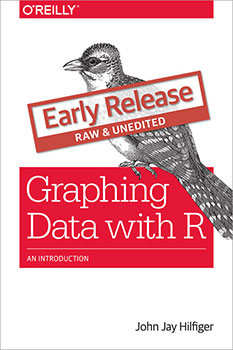John Jay Hilfiger
Create your graphs with R
A deep-dive into exploratory and presentation graphs.
Buy “Graphing Data with R: An Introduction” in early release. Editor’s note: this is an excerpt of “Graphing Data with R: An Introduction,” by John Jay Hilfiger.
Graphs are useful both for exploration and for presentation. Exploration is the process of analyzing the data and finding relationships and patterns. Presentation of your findings is making your case to others who have not studied the data as intensively as you have yourself. While one is exploring the data, graphs can be stark, lean, and somewhat unattractive. The data analyst, who knows the data and is getting to know it better with each graph made, does not need all the titles, labels, reference details, and colors that someone sitting through a presentation might expect, and might, indeed, find necessary. Furthermore, adding all this stuff just slows down the analyst. Also, some graphs will prove to be dead ends, or just not very interesting. Consequently, many graphs may be discarded during the discovery journey.As the process of exploration continues, adding some details may make relationships a little clearer. As the analyst gets closer to presentation and/or publication, the graphs become more detailed and prettier. There probably will have been many plain graphs in the process of analysis and relatively few beautiful graphs that appear in the final report. Read more…

